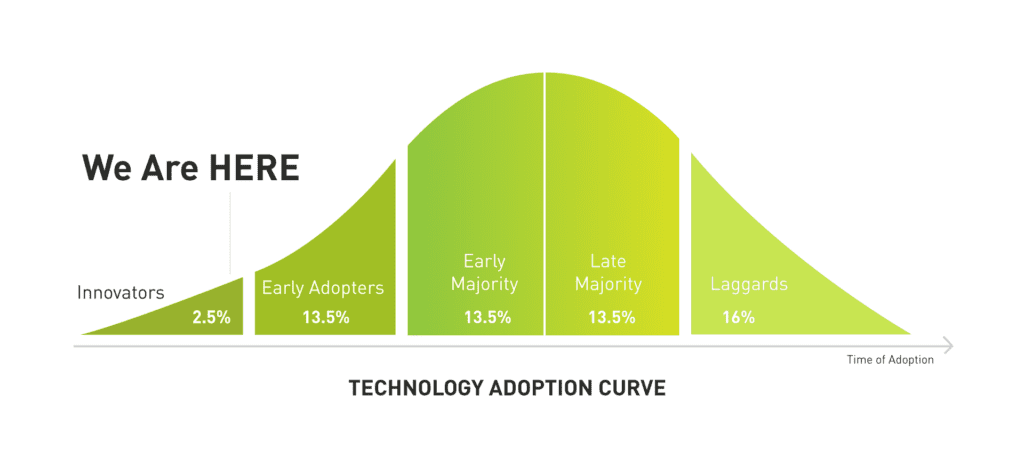
Brands and the Metaverse: What It Means for Marketers
Recently, a 13-year-old in your world may have asked for and received a popular virtual reality (VR) headset. You’ve seen them game in it. Maybe you’ve even ventured into their game world out of curiosity. Then, at the end of 2021, Mark Zuckerberg unveiled a rebranding of Facebook into Meta, its new parent company focused on a concept called the metaverse. The CEO’s speech was over an hour long and filled with concepts that may change not only how we experience social media but also how we interact with everyone in the future, at work and play. At first glance, the metaverse sounds a lot like that virtual reality game you tried. But is there more to it than these 3D games played in middle-class living rooms across the world?
In today’s edition of Plain Talk, we’ll look at brands and the metaverse—and the possible impact on your marketing plan.
- What Is the Metaverse?
- What’s Different? Meet the Zuckerverse
- What Needs to Happen for the Metaverse to Impact Brands and Marketers?
- Where Are We Now in Adoption of the Metaverse?
- Brands and the Metaverse: What Should My Company Do?
- Get Expert Help Understanding Brands and the Metaverse
What Is the Metaverse?
Today, the metaverse is an online virtual-reality space where users can interact with a computer-generated environment and other users using different peripheral devices, such as VR headsets and gaming consoles.
The term “metaverse” was coined in a fast-paced, gritty, and mythological science fiction book by Neal Stephenson called Snow Crash published in 1992. In it, the main character lives in a near-future world where, after an economic collapse, virtual reality is a place where people can go to escape the chaos of the real world. Many suspect that Snow Crash inspired Mark Zuckerberg’s vision of what the metaverse could be.
What’s Different? Meet the Zuckerverse
Meta looks to provide universal protocols to the 3D evolution of the internet. There are two main takeaways from Meta’s plans for the metaverse.
1. Human-centric vs. app-centric
We’ve all known someone, or maybe we’ve been the person, who spends hours playing World of Warcraft or some other massively multiplayer online game (MMO). In MMOs, lives are built that only exist online in a world owned and defined by a specific game creator. In their video related to the Meta launch, Vishal Shah, Vice President of Metaverse, explains how currently owning a “skin” for your avatar in a game is like going to a sporting event, buying a jersey, and only being able to wear it in that specific stadium. The current state of these online worlds is that they have boundaries that your avatar cannot cross.
Meta says it plans to shift ownership to the individual from the platform by creating an avenue for “interoperability” between virtual environments. The challenge of interoperability isn’t a new concept. In the 1990s, the internet lacked a universally accepted framework for visual communication (front-end). Then HTML arrived (along with helper protocols like CSS and JavaScript). These changes meant that you could surf a website on any device or browser and have pretty much the same web experience. That is what Zuckerberg and Meta want to do for the metaverse, but with one BIG twist—the inclusion of individual, irrefutable ownership of virtual objects, and that through cryptocurrencies, those objects have real value. (We’ll get into blockchain, non-fungible tokens (NFTs), and cryptocurrencies in a separate article.)
2. What is a “sense of presence”?
The second critical part of the Zuckerverse plan is to create what they refer to as a metaverse with a “sense of presence.” Simply put, a sense of presence in a virtual environment is defined by three requirements. First, there is the feeling of “spatial presence.” This means the feeling that you are in a defined world or space. The second aspect of presence is involvement, meaning that you can virtually touch or manipulate the virtual world and interact with its inhabitants. Third is what’s simply described as “realness.” This is merely a gauge of how real the virtual world seems to be. When combined effectively, Meta believes spatial presence, involvement, and realness will be the game-changing foundation of the ideal new metaverse experience.
Other than with MMOs, today’s online experience has mostly lacked a sense of presence. For example, while many of us feel a Brady Bunch-like sense of connectivity on Zoom calls, we do not experience a sense of presence with our meeting partners. Many pajama-pant-wearing participants toggle off their video to let the dog out or comfort a toddler. Zoom puts us in a structured grid with some limited choices for how we present ourselves (backgrounds, filters, avatars, etc.). However, there’s no way to make it feel like you are really “in the room” together.
Horizon products bring a true sense of presence
To answer the call for an interoperable metaverse with a true sense of presence, Meta is developing several products: Horizon Home, Horizon Worlds, and Horizon Workrooms. Each of these tackles the metaverse sense of presence in specific ways.
- Horizon Workrooms: Allows you and your coworkers to go into virtual meetings as avatars sitting in virtual conference rooms. Your Oculus Quest 2 headset immerses you into a three-dimensional environment and even tracks your hand movements with downward-facing sensors. You can stand up and present at a virtual board and even scan in virtual items from your real-world desktop.
- Horizon Worlds: Released in beta in the U.S. and Canada in December 2021, Horizon Worlds is an open-source online video game with an integrated game creation system. Players can explore the space around them and use controller buttons to teleport or move continuously through the virtual space. The hub world (also known as “plaza”) includes portals to featured user-generated worlds, created by players using an integrated game creation system.
- Horizon Home: Meta says that Horizon Home will serve as your personal “home” in the metaverse. But more than that, it is an immersive evolution of social media where you can virtually hang out with friends, watch videos together, and launch metaverse adventures together.
What Needs to Happen for the Metaverse to Impact Brands and Marketers?
While for some gamers, the metaverse has existed for a long time, there are really four fundamental challenges the metaverse must overcome to be mainstream.
1. Tech adoption
The adoption of new (fairly pricey) headset peripherals at a scale large enough for marketers and content makers to see the benefit in shifting investment to the platform. The reality is that even with record holiday sales of Oculus headsets in 2021, they have only shipped a total of about 10–11 million units in the U.S. since the first Oculus headset launch six years ago in 2016.
This number varies and is even lower by some accounts for how many of those shipped have been sold. So, on the high side, that’s only about 3% penetration, and many of those headsets belong to minors. In comparison, after roughly the same amount of time, the smartphone had achieved 63% penetration in the U.S. (now that number is 84%). It was the rapid adoption of mobile tech that made the channel so attractive for marketers. That adoption was helped significantly by the “free phone with a two-year contract” deals of the early 2000s.
2. Start-up costs
Assuming that this tech adoption happens (we’re confident it will), the next challenge for marketers will be the startup costs for brands to enter a completely new and untested marketing space. Much like the late nineties and the aughts, when marketers were shifting sizeable dollars to build their first websites, the metaverse will pressure brands to do the same. Timing the market to ensure dollars are being spent to the best effect will be the trick.
3. Functionality
Not wanting to be a killjoy, but for marketers to meaningfully scale the metaverse, the platform really needs to do things as well as or better than other existing media. That’s not to ignore the cool factor of the metaverse. Cool branding does matter, but it will be critical to determine what the customer experience looks like in the metaverse and come up with ways to serve up frictionless opportunities for customers and prospects in a manner that the metaverse can uniquely deliver. The most obvious way we see this manifesting is by copying a brand’s physical brand presence into the world of metaverse games. Popular restaurant chains and retailers have already begun to establish real estate in these new worlds.
4. Other marketing platforms
For marketers and brands, the metaverse needs to deliver business results as efficiently or more efficiently than current options. Today, the internet (on desktop, mobile, and voice), brick-and-mortar retail, social media, paid search, experiential marketing, and traditional media options all do an awfully good job serving people and helping them maximize convenience, price, purchase quality, and satisfaction with their purchases. While metaverse tech is admittedly cool, marketers will still need to keep one wary eye on the fundamentals because shareholders still expect to make money.
Where Are We Now in Adoption of the Metaverse?
We think it’s no coincidence that Meta made their announcement at the end of 2021. If you look at the typical tech adoption curve, the metaverse is shifting from “innovation” mode to “early adopter” mode. Those holiday Oculus sales were a sure clue. What are some of the factors driving that shift?
This would be past tense because it’s referring back to the change from HTML arriving and what it resulted in, which is how it helped in the past.

1. The pandemic changed everything
Three years ago, when someone said VR/AR, you instantly thought of video games, but then the pandemic happened. Suddenly, people started talking about virtual job fairs, virtual shopping, virtual trade shows, virtual meetings, etc. As our physical and online worlds were forced to merge into one under the pressure of sheltering in place, great strides were made toward reaching the much-promised omnichannel shopping. McKinsey has even coined the new post-pandemic shopping world “phygital“!
2. Meta created open protocols
Much like how the internet became the one we know today, partly because of open protocols like HTTP, Meta is setting the table for easy and seamless experiences in all 3D virtual worlds. This, in combination with blockchain technology, will allow for free-standing ownership of virtual assets, whether they are real estate, clothes, or currencies. Meta and the use of blockchain will make it possible for participating games, brands and worlds to become part of the grand quilt of the metaverse and for you to take your assets with you across its properties.
3. Spending is up
During Meta’s first month, they experienced hundreds of millions of dollars in transactions. Necessity is the mother of invention, and inventors are scrambling to this new virtual frontier to seek and grow their fortunes. We suspect this new energy combined with universal protocols may help to accelerate device development and adoption.
4. Social media is driving
Social media is, of course, huge. Six percent of the world’s population uses social media, and the average daily usage is 2 hours and 27 minutes. As well-known innovators and inventors in social media with existing customers in the billions, Meta is well-positioned for Horizon Home, Horizon Worlds and Workrooms to change the way we present ourselves and our companies in media.
5. Tech advances
At $299, it’s still pretty expensive for many people, but the Oculus Quest 2 headset is a big advancement over previous headsets. It is untethered and freestanding – not having to be plugged into an expensive game console or gaming computer.
6. Content
Finally, we are seeing many brands moving early to stake their claim and build content or experiences for the metaverse. While we expect some to fail (hint: don’t hold a metaverse concert), the overall mood is positive as content builders literally begin to build new worlds.
Brands and the Metaverse: What Should My Company Do?
The truth is that depending on your business vertical, the answer may be nothing (yet), but there are a few things to consider when noodling where the metaverse may fit in your marketing plan.
1. Recognize where we are in the life cycle and know it’s coming.
In 1994, when we built our first commercial website for a client, many companies were skeptical of the need to market themselves on the internet. Sears and many other traditional brick-and-mortar retailers balked at the idea of e-commerce to their detriment. That left an opening for online book retailer Amazon to take the leadership position in e-commerce and never look back. We suspect we will see some similar stories with the metaverse. In the end, we think the smart companies will spend time now studying and experimenting with the channel and closely watching competitors figure out the best metaverse strategies.
2. Understand that brands do and will increasingly find place and value from their physical goodwill in the virtual worlds.
Your brand(s) may have tremendous unrecognized virtual goodwill that can be turned into real revenue! Still, the startup costs for your brand(s) to enter a completely new and untested marketing space needs to be carefully contemplated before making the jump. Also, unless early technology adoption is part of your brand identity, the metaverse needs to deliver business results as efficiently or more efficiently than your current tech for you to invest.
3. Create a concept team to investigate opportunities.
Assemble a diverse group of intellectually curious team members at your company to learn about and lead your company into the more immersive augmented and virtual world. In addition to gender and ethnic diversity, the group should be diverse in title, age and level of tech-savviness. You don’t want all dreamers and tech nerds in the group, but you want some! Buy them headsets. They need to be experiencing, not just studying.
4. Focus on function and metrics.
Work with your team and your agency to determine how you will use the metaverse and measure its effectiveness. We suspect that the brands that figure this out early in their vertical will be the brands that win share for the next few decades.
Get Expert Help Understanding Brands and the Metaverse
While you may not need to dive headfirst into the metaverse, now is a great time to start to think about YOUR needs and how the metaverse can best serve you and your customers. In our next metaverse article, we will address some industry-specific metaverse opportunities we foresee.
If you have any questions about this article or want to talk more about how your brand might benefit from entering the metaverse early, please give us a shout or call 502-499-4209.
Our Articles Delivered
Signup to receive our latest articles right in your inbox.


